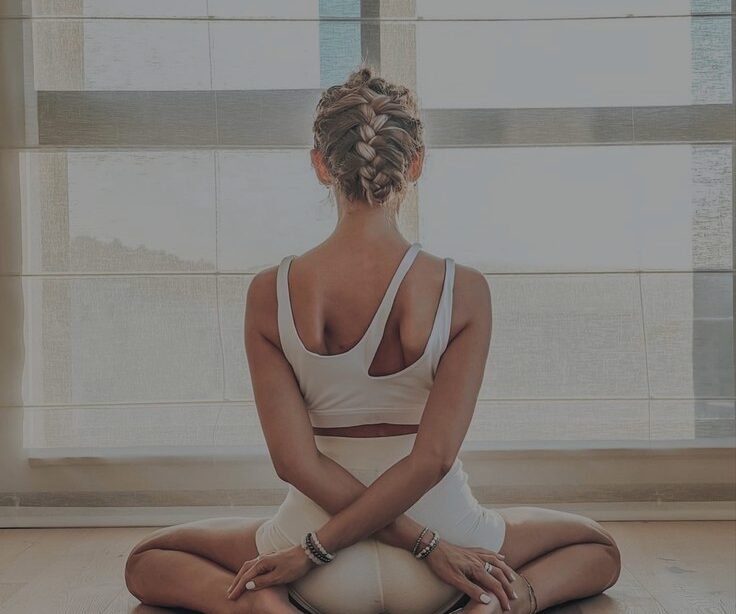The most low-key, quietly powerful benefit of yoga is how it tunes your mind and body into a calm, balanced rhythm. It’s like rewiring yourself, but from the inside out.
Think of it this way: in everyday life, stress, worries, and all that constant chatter in your head can make you feel scattered and a bit on edge. With yoga, the movements and breathwork sneakily help turn down that mental noise. Your body starts to feel more in sync, your brain feels clearer, and your emotions are less all over the place.
On a deeper level, it makes you more connected with how your body feels and what it needs. Those stretches and breathing techniques aren’t just random poses—they’re cues teaching you to notice tension, tightness, or fatigue before they become bigger issues. You’re basically learning to read yourself better.
Over time, this all adds up to being more present. It’s not flashy or obvious, but yoga kind of gives you this toolkit for being more patient, focused, and in control of how you react to things, which really changes how you go through life.
In this article
The least low-key benefit of yoga is how it boosts your flexibility and strength. It’s the most noticeable part because you can actually feel and see the changes. Suddenly, you’re reaching down and touching your toes, or holding a challenging pose longer than you thought you could.
It’s not just flexibility, though; yoga also builds up your core, arms, legs, and stabilizing muscles in a way that other workouts often miss. Those movements that seem slow and smooth are secretly pushing your muscles, giving you both power and balance. You feel more capable—like you could handle a spontaneous hike, lift heavier things with better form, or just move through life with less stiffness and pain.
Plus, there’s something uplifting about seeing progress on the mat. You can’t really miss it, and that motivates you to keep showing up. That “I feel stronger and more flexible” boost is definitely the least subtle perk that keeps people hooked.
7 things to be curious about if you’re considering becoming a yoga instructor or opening a yoga studio
Considering becoming a yoga instructor? Start by asking yourself some key questions. What kind of atmosphere would you want to create in your classes? Would it be high-energy, meditative, or something in between? And which style of yoga would best reflect that vision?
Think about anatomy and physiology: how deeply do you understand the body’s mechanics? Could you guide others with confidence, making adjustments that keep students safe and engaged?
Yoga is also about philosophy and mindfulness. Are you drawn to these elements, ready to weave them into your teaching? Beyond the physical movements, could you create a space that fosters mental and emotional growth?
Then there’s the business side—how prepared are you to manage finances, brand-building, and marketing to make your studio or classes stand out? Who would be your ideal audience, and how would you design a studio that resonates with them specifically?
And what about certification? Would you be excited to go through training hours, learning from others, and building skills that reflect your style?
Finally, what does community mean to you? Would you aim to create a welcoming, inclusive environment that keeps people coming back, where they feel supported and connected?
These questions don’t just shape your journey; they reveal the true depth of what it means to teach yoga. The answers lie in exploring, learning, and bringing a unique vision to life.
#1 – STYLES OF YOGA
There are many different types of yoga. Understanding each style’s vibe, physical intensity, and audience is essential to know what kind of classes or studio you want to offer.
The logic here is about aligning your skills and services with a specific focus. Each type of yoga has its own structure, pace, and benefits, and it appeals to different types of people for different reasons. Knowing these distinctions is essential because it allows you to define a clear direction for your teaching or studio.
When you understand the characteristics of each yoga style, you can make informed choices about which one resonates most with your personal strengths, goals, and the kind of experience you want to create for others. It’s a strategic approach to designing a service that caters to a specific group rather than offering something broad and unfocused. This clarity not only makes you a more effective teacher but also helps potential clients identify with what you offer, setting the foundation for a successful and meaningful yoga practice or business.
#2 – ANALOGY & PHYSIOLOGY
Yoga instructors need a basic understanding of body mechanics to guide students safely, prevent injuries, and adapt poses for different abilities.
When I say you need to understand body mechanics as a yoga instructor, it means you’ll need to know how the body moves—how the muscles, joints, and bones work together when people stretch and move. This isn’t just about showing poses; it’s about understanding how to move in a way that’s safe and beneficial for the body.
If you have a good grasp of this, you’ll be able to guide your students safely. You’ll spot if someone is doing a pose wrong or pushing too hard, which could lead to strain or injury. With this knowledge, you can step in and offer corrections that keep everyone safe while still allowing them to benefit from the practice.
And knowing body mechanics also lets you adapt poses for different people. Not everyone has the same flexibility or strength, so you’ll be able to modify poses for beginners or people with injuries. This ensures everyone can participate, even if their body doesn’t move exactly like someone else’s.
#3 – PHYSICAL DEMANDS & INJURIES
Yoga might look serene, but teaching it regularly is a workout, plus you’ll be demonstrating poses, adjusting students, and holding space energetically.
It’s probably crossed your mind the hidden toll teaching yoga might take on your body and energy.
Sounds straightforward: teach poses, guide students through flows, all in the calm, peaceful setting of a yoga studio, but really, you’re moving, speaking, adjusting, and engaging physically and mentally for hours every day.
Most jobs don’t require you to move constantly, communicate non-stop, and stay hyper-aware of everyone around you.
This setup for yoga teachers doesn’t just make it “active”; it’s repetitively demanding, like putting your body in a low-key endurance test every class, which stacks up.
Injuries sneak up over time, especially if you’re not pacing yourself or getting too comfortable overextending, thinking your body can handle anything.
The advice here is strategic self-preservation.
You need to be aware of common physical strain points and actively protect your body to avoid burnout or injury. In essence, it’s not enough to just love yoga; teaching it long-term means being smart about how you give yourself to it.
Inquire about common instructor injuries, and make sure you know how to protect your body over a long teaching career.
You might demonstrate poses several times per class—over and over, day after day. This repetition stresses joints and muscles, particularly in the wrists, shoulders, and knees. Teachers often face overuse injuries that would rarely affect casual practitioners, so learning how to demo selectively is key to avoiding strain.
Physically assisting students—helping them into deeper stretches, aligning their posture—sounds harmless but can seriously strain your back, shoulders, and hips if you’re not mindful. This is one of those unspoken hazards of yoga instruction; improper lifting or leaning while adjusting someone can lead to muscle tears, sprains, or even chronic pain over time.
Many yoga studios have hard floors, which over time can put stress on your feet, knees, and lower back, especially since yoga teachers are often barefoot. Long hours of walking, standing, and balancing barefoot in a studio can create or worsen foot issues, knee pain, or joint discomfort, which instructors might overlook until it becomes serious.
Voice issues are surprisingly common for yoga teachers since you’re consistently speaking in a controlled, often gentle tone for long periods. Over time, this can lead to vocal strain, hoarseness, or even more serious issues with your vocal cords if you’re not mindful of resting and hydrating your voice between classes.
Holding space means staying attuned to the room’s energy, focusing on everyone’s progress and comfort. Even in calm, low-key sessions, this focus can lead to mental fatigue. Teachers report that this need for sustained presence becomes a draining physical sensation after teaching multiple classes, eventually affecting physical health.
If you’re teaching in hot yoga studios, add heat exhaustion or dehydration to the list. Teaching back-to-back classes in heated rooms increases the risk of dehydration, dizziness, and even long-term cardiovascular strain if you’re not vigilant about hydration and breaks.
Being aware of these demands early lets you set boundaries, take precautions, and build habits that support you physically and mentally, so you’re not sidelined by any of these issues as you progress in your career.
#4 – BUSINESS & MARKETING BASICS
Having a yoga studio is not just about providing a space for people to roll out their mats and feel good. The real backbone of keeping it alive is knowing how to run it like a business, which means making smart choices on multiple fronts—financial, strategic, and creative.
Managing finances here isn’t just “balancing the books”; it’s understanding revenue streams, tracking monthly expenses, and being sharp about cash flow so that you’re not only covering costs but also reinvesting to grow.
What can I charge? What extras can I offer? What’s my profit after all bills and salaries?
Building a brand is how you communicate what makes your studio special to clients who have options.
Branding defines your studio’s feel and makes people choose you. This goes hand-in-hand with having a strong online presence, which is crucial for visibility in a world where clients are researching everything online. Your website, social media, reviews—these are key to creating trust before they even walk in the door.
It isn’t enough to love yoga or to have the dream of owning a studio. You need the chops to run it like a business, handling each of these factors strategically. The more you nail these fundamentals, the more freedom you have to actually enjoy the work.
And getting clients in the door is just one part of the equation. Retention—keeping them coming back—takes focus. This could involve loyalty programs, membership packages, personalized follow-ups, or monthly workshops to give them a reason to stay connected. High retention is often what stabilizes your revenue and builds a solid, loyal community.
Keeping tabs on what other local studios, gyms, or even online yoga services are offering will help you spot gaps in the market and ensure your services stay unique and relevant. It’s about seeing what’s out there, what’s working, and positioning yourself smartly to stand out.
Deciding on your pricing structure is more than just about covering expenses. It means carefully calculating class prices, memberships, and add-ons (like private sessions or merchandise) to the point where you’re making enough to grow the business without pricing clients out.
Running a studio has a legal side—permits, waivers, liability insurance, and employment contracts. If you don’t cover these bases, one unexpected issue could become a huge problem. The smartest approach here is proactive, ensuring you’re legally protected and compliant with all necessary regulations.
#5 – CLIENT NEEDS & DEMOGRAPHIC
When you’re building anything that serves people—whether it’s a yoga class schedule, a product, or an experience—the key isn’t just offering what you think is great but delivering what each type of client needs and values. And that means seeing the whole scope of preferences and motivations across different client groups.
For example, in a yoga studio, you’re likely dealing with diverse groups: beginners, advanced practitioners, maybe even people coming in for rehabilitation or stress relief. Each group has unique needs, from class pace and teacher style to the time slots they’re most likely to attend. Beginners might want foundational classes and approachable instructors, while advanced clients might crave high-intensity, challenging flows with deeper, more philosophical instruction.
Clients often crave variety not just in physical intensity but in mental focus. Some come for meditation-based classes, while others want purely physical sessions. Offering a balance—like Yin for mental calmness versus Vinyasa for a dynamic workout—shows you understand that clients’ needs can change daily.
Many clients have strong preferences regarding music (or silence), lighting, and even room temperature. Offering sessions with different sensory environments (e.g., heated versus cool rooms, or sessions with soft background music versus silence) acknowledges that people’s sensory preferences impact their experience as much as the practice itself.
Rigid membership plans can deter clients who have unpredictable schedules or only want occasional classes. Having flexible payment options—drop-ins, class packs, online access—shows you’re aware that everyone’s schedule and budget vary, especially for clients who may only come when they need a mental reset.
#6 – YOGA CERTIFICATIONS & TRAINING
Not all certifications are created equal, and in yoga, this can be a major deal. Research which programs are respected and understand the difference between a 200-hour certification (the basic requirement to teach) and advanced 300- or 500-hour trainings.
the certification program you choose isn’t just a formality. It’s the foundation of your credibility, skill set, and marketability. Not all certifications carry the same weight in the industry, and picking the right one affects everything from how potential employers view you to the depth of your teaching knowledge.
A 200-hour certification is the industry’s minimum standard—it qualifies you to teach but often only scratches the surface of deeper anatomy, advanced poses, sequencing, and the subtleties of guiding different client types. A 300- or 500-hour program, though, dives much further into advanced techniques, therapeutic practices, and specialized skills (like prenatal yoga or injury-specific adaptations). These programs give you the tools and knowledge to attract a wider client base and confidently handle complex teaching scenarios.
From a strategic perspective, choosing a respected, in-depth certification signals to clients and employers that you’re not only qualified but serious and well-trained. High-caliber programs can open doors to better teaching positions, draw clients who prioritize instructor expertise, and set you apart in a crowded market. It’s an investment in credibility, long-term career growth, and the ability to build a reputation rooted in expertise, not just in basic competency.
Some programs are heavy on theory but light on practical teaching experience. Programs with significant hands-on hours (where you actually teach peers or classes under supervision) are invaluable for building real confidence, refining your style, and getting comfortable with real-time adjustments and cueing before you’re on your own.
Quality training programs emphasize in-depth anatomy and injury prevention, which is crucial for teaching safely and effectively. Look for programs that don’t just skim over anatomy but dig deep into biomechanics, adjustments, and modifications, equipping you with skills to prevent injuries and adapt practices for different bodies.
Not all yoga certification programs are accredited by a recognized body, like Yoga Alliance, which is often viewed as the “standard” in the industry. Employers, studios, and insurance companies may require an accredited certification, so confirming a program’s accreditation before enrolling helps ensure it’s widely respected and accepted.
Certain client groups—like seniors, children, or those with disabilities—often require specialized training. Certifications in these niches (e.g., yoga therapy, trauma-informed yoga, or prenatal yoga) make your teaching more versatile and accessible, enabling you to attract a broader, loyal clientele and work in diverse settings, including hospitals, schools, and wellness centers.
#7 – INSURANCE LIABILITY & SAFETY
As a yoga instructor or studio owner, you’re responsible for people’s physical well-being. This puts you in a position where, if someone gets injured—no matter how minor or rare—legal and financial consequences could follow if you’re not protected.
Liability insurance covers legal costs, medical expenses, or damages in case a client claims injury or harm from your instruction or your studio environment. Without it, a single lawsuit could drain your personal finances or even shut down your studio. Even minor claims can be expensive to defend, so having this protection is crucial to avoid risking your assets or business.
Clients trust that they’re in safe hands when they see an instructor or studio carrying valid insurance. It’s an assurance that you take safety and professionalism seriously, and that you’re prepared for any situation. In some cases, insurance coverage can also be a legal requirement for renting studio space or working with clients in specific settings, like schools or corporate environments.
General liability insurance covers incidents like slip-and-fall accidents on studio premises, while professional liability (or malpractice) insurance specifically covers claims related to your instruction, such as injuries resulting from certain poses or adjustments. Having both types means you’re covered across different scenarios, minimizing potential gaps that could leave you exposed.
Insurance isn’t a substitute for safe teaching practices; it’s a last line of defense. Strategically, you want a proactive approach to safety—like limiting class sizes, thoroughly cleaning equipment, and knowing proper alignment techniques. This minimizes risk, prevents injuries, and strengthens your credibility, which can ultimately reduce your insurance premiums over time.
Liability waivers and contracts help clarify the risks associated with yoga practice and set boundaries for responsibility. These documents don’t always prevent lawsuits, but they can protect you by showing that clients were informed of risks before participating. They’re essential legal tools for both individual instructors and studio owners, helping to manage expectations and legally reinforce that clients have accepted certain risks.



